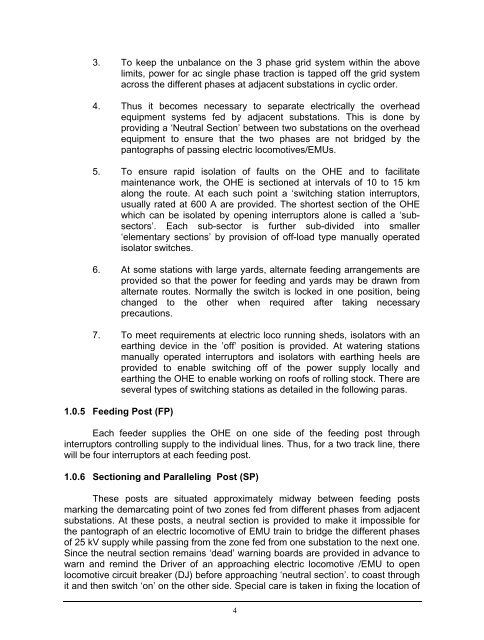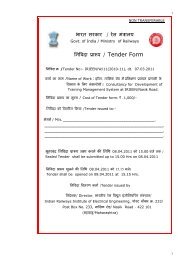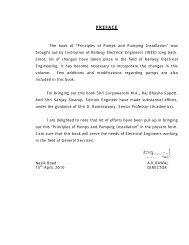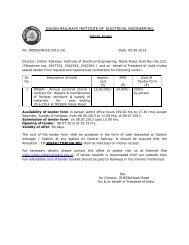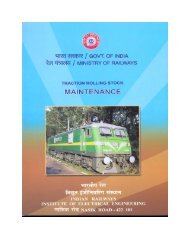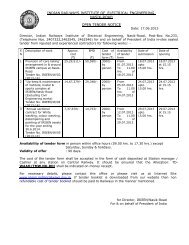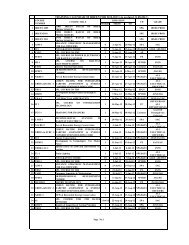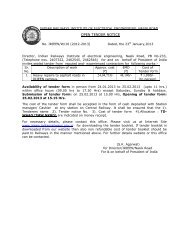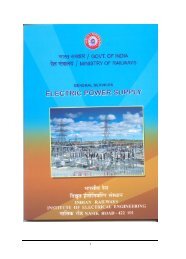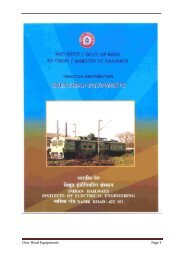remote control equipment - Indian Railways Institute of Electrical ...
remote control equipment - Indian Railways Institute of Electrical ...
remote control equipment - Indian Railways Institute of Electrical ...
Create successful ePaper yourself
Turn your PDF publications into a flip-book with our unique Google optimized e-Paper software.
3. To keep the unbalance on the 3 phase grid system within the above<br />
limits, power for ac single phase traction is tapped <strong>of</strong>f the grid system<br />
across the different phases at adjacent substations in cyclic order.<br />
4. Thus it becomes necessary to separate electrically the overhead<br />
<strong>equipment</strong> systems fed by adjacent substations. This is done by<br />
providing a ‘Neutral Section’ between two substations on the overhead<br />
<strong>equipment</strong> to ensure that the two phases are not bridged by the<br />
pantographs <strong>of</strong> passing electric locomotives/EMUs.<br />
5. To ensure rapid isolation <strong>of</strong> faults on the OHE and to facilitate<br />
maintenance work, the OHE is sectioned at intervals <strong>of</strong> 10 to 15 km<br />
along the route. At each such point a ‘switching station interruptors,<br />
usually rated at 600 A are provided. The shortest section <strong>of</strong> the OHE<br />
which can be isolated by opening interruptors alone is called a ‘subsectors’.<br />
Each sub-sector is further sub-divided into smaller<br />
‘elementary sections’ by provision <strong>of</strong> <strong>of</strong>f-load type manually operated<br />
isolator switches.<br />
6. At some stations with large yards, alternate feeding arrangements are<br />
provided so that the power for feeding and yards may be drawn from<br />
alternate routes. Normally the switch is locked in one position, being<br />
changed to the other when required after taking necessary<br />
precautions.<br />
7. To meet requirements at electric loco running sheds, isolators with an<br />
earthing device in the ’<strong>of</strong>f’ position is provided. At watering stations<br />
manually operated interruptors and isolators with earthing heels are<br />
provided to enable switching <strong>of</strong>f <strong>of</strong> the power supply locally and<br />
earthing the OHE to enable working on ro<strong>of</strong>s <strong>of</strong> rolling stock. There are<br />
several types <strong>of</strong> switching stations as detailed in the following paras.<br />
1.0.5 Feeding Post (FP)<br />
Each feeder supplies the OHE on one side <strong>of</strong> the feeding post through<br />
interruptors <strong>control</strong>ling supply to the individual lines. Thus, for a two track line, there<br />
will be four interruptors at each feeding post.<br />
1.0.6 Sectioning and Paralleling Post (SP)<br />
These posts are situated approximately midway between feeding posts<br />
marking the demarcating point <strong>of</strong> two zones fed from different phases from adjacent<br />
substations. At these posts, a neutral section is provided to make it impossible for<br />
the pantograph <strong>of</strong> an electric locomotive <strong>of</strong> EMU train to bridge the different phases<br />
<strong>of</strong> 25 kV supply while passing from the zone fed from one substation to the next one.<br />
Since the neutral section remains ‘dead’ warning boards are provided in advance to<br />
warn and remind the Driver <strong>of</strong> an approaching electric locomotive /EMU to open<br />
locomotive circuit breaker (DJ) before approaching ‘neutral section’. to coast through<br />
it and then switch ‘on’ on the other side. Special care is taken in fixing the location <strong>of</strong><br />
4


